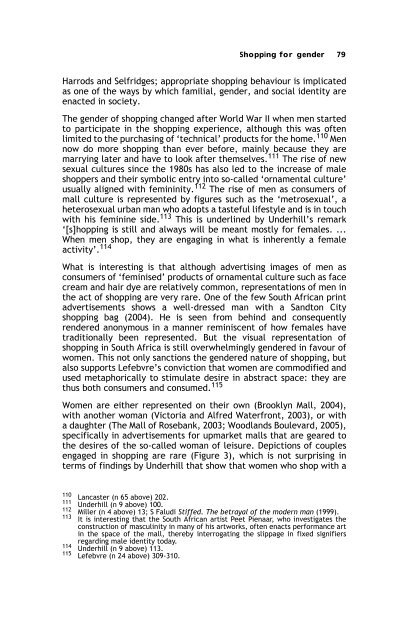Sex, Gender, Becoming - PULP
Sex, Gender, Becoming - PULP
Sex, Gender, Becoming - PULP
Create successful ePaper yourself
Turn your PDF publications into a flip-book with our unique Google optimized e-Paper software.
Shopping for gender 79<br />
Harrods and Selfridges; appropriate shopping behaviour is implicated<br />
as one of the ways by which familial, gender, and social identity are<br />
enacted in society.<br />
The gender of shopping changed after World War II when men started<br />
to participate in the shopping experience, although this was often<br />
limited to the purchasing of ‘technical’ products for the home. 110 Men<br />
now do more shopping than ever before, mainly because they are<br />
marrying later and have to look after themselves. 111 The rise of new<br />
sexual cultures since the 1980s has also led to the increase of male<br />
shoppers and their symbolic entry into so-called ‘ornamental culture’<br />
usually aligned with femininity. 112 The rise of men as consumers of<br />
mall culture is represented by figures such as the ‘metrosexual’, a<br />
heterosexual urban man who adopts a tasteful lifestyle and is in touch<br />
with his feminine side. 113 This is underlined by Underhill’s remark<br />
‘[s]hopping is still and always will be meant mostly for females. ...<br />
When men shop, they are engaging in what is inherently a female<br />
activity’. 114<br />
What is interesting is that although advertising images of men as<br />
consumers of ‘feminised’ products of ornamental culture such as face<br />
cream and hair dye are relatively common, representations of men in<br />
the act of shopping are very rare. One of the few South African print<br />
advertisements shows a well-dressed man with a Sandton City<br />
shopping bag (2004). He is seen from behind and consequently<br />
rendered anonymous in a manner reminiscent of how females have<br />
traditionally been represented. But the visual representation of<br />
shopping in South Africa is still overwhelmingly gendered in favour of<br />
women. This not only sanctions the gendered nature of shopping, but<br />
also supports Lefebvre’s conviction that women are commodified and<br />
used metaphorically to stimulate desire in abstract space: they are<br />
thus both consumers and consumed. 115<br />
Women are either represented on their own (Brooklyn Mall, 2004),<br />
with another woman (Victoria and Alfred Waterfront, 2003), or with<br />
a daughter (The Mall of Rosebank, 2003; Woodlands Boulevard, 2005),<br />
specifically in advertisements for upmarket malls that are geared to<br />
the desires of the so-called woman of leisure. Depictions of couples<br />
engaged in shopping are rare (Figure 3), which is not surprising in<br />
terms of findings by Underhill that show that women who shop with a<br />
110 Lancaster (n 65 above) 202.<br />
111<br />
Underhill (n 9 above) 100.<br />
112 Miller (n 4 above) 13; S Faludi Stiffed. The betrayal of the modern man (1999).<br />
113 It is interesting that the South African artist Peet Pienaar, who investigates the<br />
construction of masculinity in many of his artworks, often enacts performance art<br />
in the space of the mall, thereby interrogating the slippage in fixed signifiers<br />
regarding male identity today.<br />
114<br />
Underhill (n 9 above) 113.<br />
115 Lefebvre (n 24 above) 309-310.
















